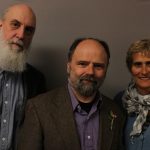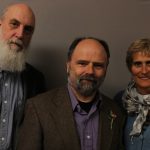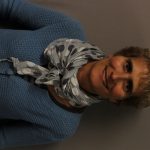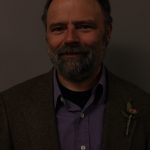Lou Host-Jablonski, Jon Edwards, and Brenda Baker
Description
Brenda Baker (48) interviews Lou Host-Jabonski (60) and Jon Edwards (53) about the projects and exhibits they've worked on at the Madison Children's Museum.Subject Log / Time Code
Participants
- Lou Host-Jablonski
- Jon Edwards
- Brenda Baker
Recording Locations
Madison Children's MuseumVenue / Recording Kit
Tier
Partnership
Partnership Type
Fee for ServiceKeywords
Subjects
People
Transcript
StoryCorps uses Google Cloud Speech-to-Text and Natural Language API to provide machine-generated transcripts. Transcripts have not been checked for accuracy and may contain errors. Learn more about our FAQs through our Help Center or do not hesitate to get in touch with us if you have any questions.
00:04 I'm Brenda Baker. I'm 48 years old. Today's date is April 19th, 2012. We're at Madison Children's Museum and I may be talking with John Edwards and lujo stefanski and both our colleagues. I've only worked with the children's museum for the last well, John 20 years and Lou probably at least 15 Bluehost. Jablonski. I just turned 60 today's date is 19th of April nine days after my birthday and we're here at the Madison Children's Museum and I'm with Brenda Baker and John Edwards who are cool makers of exhibits and facilities at the Madison Children's Museum.
00:50 I'm John Edwards on
00:55 Sorry.
00:57 53 I believe this is the 19th of April 2012 this the Madison Children's Museum in the end and I'm speaking with the Brenda Baker and blue holster jablonski.
01:16 I just wanted to start out by just saying that for me it's been such a huge privilege to work with both of you at the museum for the for the past while I've been here Twenty One years and John, I guess 20 and and for me I I feel like one of the biggest gifts that I've had. My job is is getting to work with really creative and inventive people and one of them did the sort of the most significant experiences for me was hiring John Edwards start at the Children's Museum just because I feel like you know, he had all the tools and all the gifts that we needed to sort of Trance from this place. And I remember John when you first came in for your first interview, you know, I didn't know at the time that you hadn't had a stroke and that was why you didn't speak so much but you brought an enormous like a pile of like five photo albums of all the work that you've done and I remember you didn't you didn't say much but you I looked at these photo albums and I just I kept asking you did.
02:16 Make this do you make this and you said yes, ma'am? Yes, ma'am, and it was things like you know that
02:22 Stained glass windows in the chain mail and you know jackets that you had made and you know sweaters that you would crocheted or knitted and it just everything under the sun blacksmithing and I thought this is this person is absolutely the kind of renaissance man. We need at the Museum who can just actually think of think of and make anything so and I wonder if you guys if you've done it and Louis you could talk about sort of your most memorable projects that we worked on together at the Museum. I don't know who wants to start.
02:59 Well, I remember, you know way back when working in the Bedford Street project and actually don't remember much of does what 20 25 30 years ago, so I don't really remember much about that. But what I do remember is is working on the first first Feats what I think was the first first sweets and I think you guys came to didn't come to my house and do a straw clay workshop and we were thinking about we should do some some sort of straw clay structure for first feets. And then that's what I grew like Topsy and I actually have the distinct memory of being a little confused.
03:35 By the the the the brief, you know the instructions because I had such high regard for you guys that I could all I could think of was like, why do they need me? You know, I'm just drawing pictures here. This is like, you know, they can I just you know, what do I have to add really you don't so so the straw clipart pot part was a point of entry to me. You know, it took like oh, yeah, we can do that then I guess I'm I'm I know that stuff and we can do that. It wasn't until working on this project here. This is the name of the new Museum. We're in now where I got a better sense of like how I should do or what was needed and so that for me it really started three years of just of of pure joy really working with this team working with essentially this this massive.
04:30 Art project collaborative art project where what was Brenda like 200 artists or you know the numbers and then who knows how many others are still just with all the heart and soul and it's it's it's um, you know, I've been working as an architect for 35 some years and this is this project is unlike anything I've ever done not that there wasn't creativity and hard another projects. But the the the what I what we were talking about earlier this notion that somehow the museum put together a support structure for this this heartfelt Excellence on everybody's part day after day after day to me. That's the real achievement. Is that is that that support structure that support of
05:24 Odd funny creative slightly dysfunctional people, you know for years and in the building is a is a visual record of that but it isn't the thing, you know that the real cheap. When is that is that to me? Was that process was that was that experience working with us people?
05:47 Don Diva Asian exhibits initiative by the way Foundation. It was really unique when we first talked to them. They're very reserved. We couldn't get much of anything out. But after a while once they get to know us so we can walk up there in her child and in need to take a look at that has has
06:39 Work for is his family and and got the job done and and and he sent, you know, I'm retired and and he
06:52 It doesn't. He's not connected with his childhood again and you know after speaking with us and we find out exactly what they did as a child. Now in in the different camps. They ran the homes they rented in the lost and it was a really unique actually waking up the the the Elder Sam Hunt. I specially liked seeing you out in that project working with the elders when you were building a prototype house. I remember that when we first tried to explain to the Hmong Elders that we wanted to build a house in our museum for people to see that they didn't understand it at all because they had no concept of what a museum was and they they did they didn't get it and they said you can't do that because it's not big enough for a real house. And so I'm so then we decided to build a prototype house out on the property of Mendota Mental Health Institute where most of the kitten most of these Elders word, you know.
07:52 Denton right and and it was only then when John started working with the team of Elders that that I think I really understood what it was we were trying to do and they also really understood the Integrity of our vision and that we were really wanting them to their voices to be heard that this was a museum that this was an exhibit. It was really about them. So I love watching you work with them and sort of learned from them how to build a traditional mom's house. So even though there was no lie, no shared language. They really taught us how to build that that prototype house and then went on to use it for several years for their on their own property their children.






